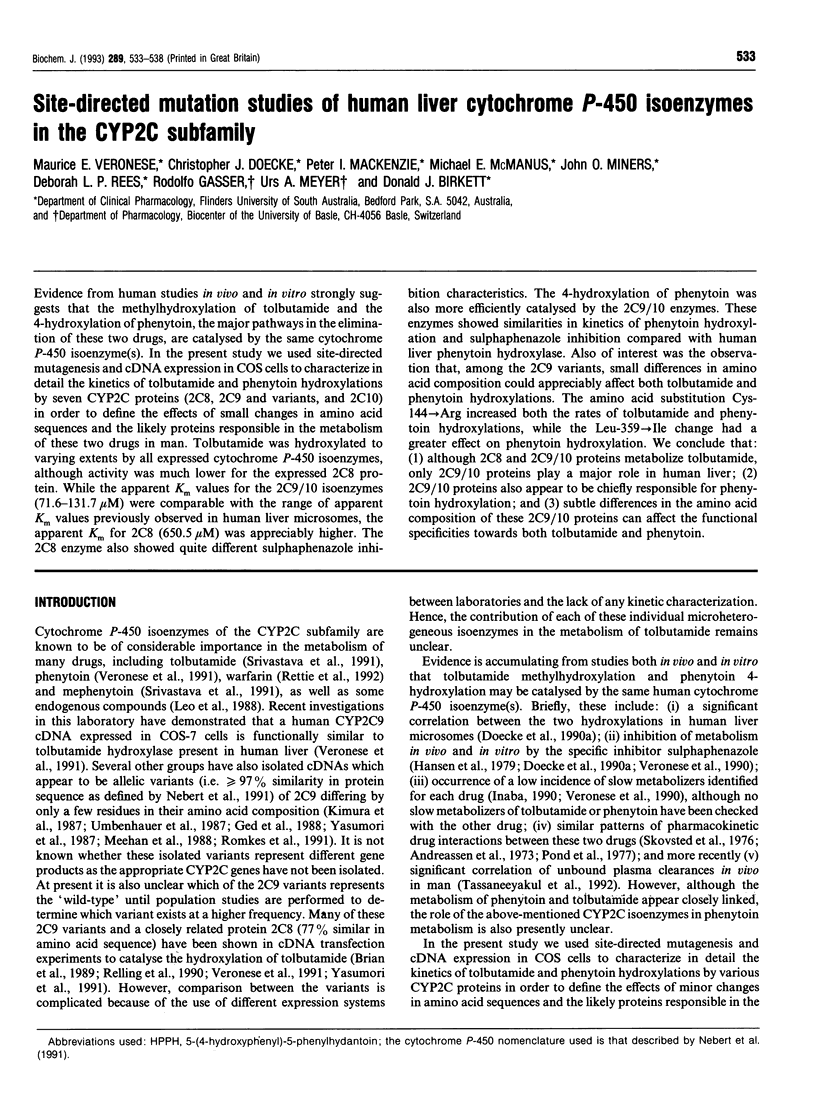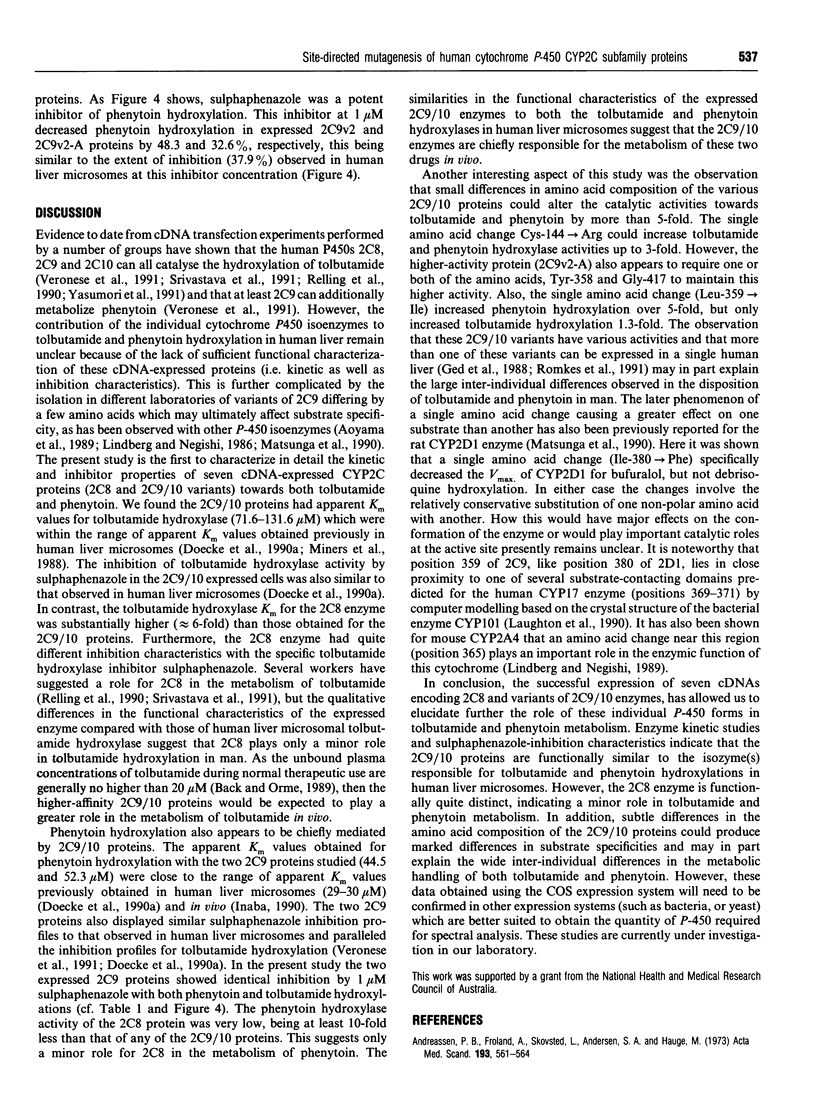Abstract
Evidence from human studies in vivo and in vitro strongly suggests that the methylhydroxylation of tolbutamide and the 4-hydroxylation of phenytoin, the major pathways in the elimination of these two drugs, are catalysed by the same cytochrome P-450 isoenzyme(s). In the present study we used site-directed mutagenesis and cDNA expression in COS cells to characterize in detail the kinetics of tolbutamide and phenytoin hydroxylations by seven CYP2C proteins (2C8, 2C9 and variants, and 2C10) in order to define the effects of small changes in amino acid sequences and the likely proteins responsible in the metabolism of these two drugs in man. Tolbutamide was hydroxylated to varying extents by all expressed cytochrome P-450 isoenzymes, although activity was much lower for the expressed 2C8 protein. While the apparent Km values for the 2C9/10 isoenzymes (71.6-131.7 microM) were comparable with the range of apparent Km values previously observed in human liver microsomes, the apparent Km for 2C8 (650.5 microM) was appreciably higher. The 2C8 enzyme also showed quite different sulphaphenazole inhibition characteristics. The 4-hydroxylation of phenytoin was also more efficiently catalysed by the 2C9/10 enzymes. These enzymes showed similarities in kinetics of phenytoin hydroxylation and sulphaphenazole inhibition compared with human liver phenytoin hydroxylase. Also of interest was the observation that, among the 2C9 variants, small differences in amino acid composition could appreciably affect both tolbutamide and phenytoin hydroxylations. The amino acid substitution Cys-144-->Arg increased both the rates of tolbutamide and phenytoin hydroxylations, while the Leu-359-->Ile change had a greater effect on phenytoin hydroxylation. We conclude that: (1) although 2C8 and 2C9/10 proteins metabolize tolbutamide. only 2C9/10 proteins play a major role in human liver; (2) 2C9/10 proteins also appear to be chiefly responsible for phenytoin hydroxylation; and (3) subtle differences in the amino acid composition of these 2C9/10 proteins can affect the functional specificities towards both tolbutamide and phenytoin.
Full text
PDF





Images in this article
Selected References
These references are in PubMed. This may not be the complete list of references from this article.
- Aoyama T., Korzekwa K., Nagata K., Adesnik M., Reiss A., Lapenson D. P., Gillette J., Gelboin H. V., Waxman D. J., Gonzalez F. J. Sequence requirements for cytochrome P-450IIB1 catalytic activity. Alteration of the stereospecificity and regioselectivity of steroid hydroxylation by a simultaneous change of two hydrophobic amino acid residues to phenylalanine. J Biol Chem. 1989 Dec 15;264(35):21327–21333. [PubMed] [Google Scholar]
- Back D. J., Orme M. L. Genetic factors influencing the metabolism of tolbutamide. Pharmacol Ther. 1989;44(2):147–155. doi: 10.1016/0163-7258(89)90064-8. [DOI] [PubMed] [Google Scholar]
- Brian W. R., Srivastava P. K., Umbenhauer D. R., Lloyd R. S., Guengerich F. P. Expression of a human liver cytochrome P-450 protein with tolbutamide hydroxylase activity in Saccharomyces cerevisiae. Biochemistry. 1989 Jun 13;28(12):4993–4999. doi: 10.1021/bi00438a014. [DOI] [PubMed] [Google Scholar]
- Doecke C. J., Sansom L. N., McManus M. E. Phenytoin 4-hydroxylation by rabbit liver P450IIC3 and identification of orthologs in human liver microsomes. Biochem Biophys Res Commun. 1990 Jan 30;166(2):860–866. doi: 10.1016/0006-291x(90)90889-u. [DOI] [PubMed] [Google Scholar]
- Doecke C. J., Veronese M. E., Pond S. M., Miners J. O., Birkett D. J., Sansom L. N., McManus M. E. Relationship between phenytoin and tolbutamide hydroxylations in human liver microsomes. Br J Clin Pharmacol. 1991 Feb;31(2):125–130. doi: 10.1111/j.1365-2125.1991.tb05499.x. [DOI] [PMC free article] [PubMed] [Google Scholar]
- Ged C., Umbenhauer D. R., Bellew T. M., Bork R. W., Srivastava P. K., Shinriki N., Lloyd R. S., Guengerich F. P. Characterization of cDNAs, mRNAs, and proteins related to human liver microsomal cytochrome P-450 (S)-mephenytoin 4'-hydroxylase. Biochemistry. 1988 Sep 6;27(18):6929–6940. doi: 10.1021/bi00418a039. [DOI] [PubMed] [Google Scholar]
- Hansen J. M., Kampmann J. P., Siersbaek-Nielsen K., Lumholtz I. B., Arrøe M., Abildgaard U., Skovsted L. The effect of different sulfonamides on phenytoin metabolism in man. Acta Med Scand Suppl. 1979;624:106–110. doi: 10.1111/j.0954-6820.1979.tb00729.x. [DOI] [PubMed] [Google Scholar]
- Inaba T. Phenytoin: pharmacogenetic polymorphism of 4'-hydroxylation. Pharmacol Ther. 1990;46(3):341–347. doi: 10.1016/0163-7258(90)90022-t. [DOI] [PubMed] [Google Scholar]
- Kimura S., Pastewka J., Gelboin H. V., Gonzalez F. J. cDNA and amino acid sequences of two members of the human P450IIC gene subfamily. Nucleic Acids Res. 1987 Dec 10;15(23):10053–10054. doi: 10.1093/nar/15.23.10053. [DOI] [PMC free article] [PubMed] [Google Scholar]
- Laughton C. A., Neidle S., Zvelebil M. J., Sternberg M. J. A molecular model for the enzyme cytochrome P450(17 alpha), a major target for the chemotherapy of prostatic cancer. Biochem Biophys Res Commun. 1990 Sep 28;171(3):1160–1167. doi: 10.1016/0006-291x(90)90806-x. [DOI] [PubMed] [Google Scholar]
- Leo M. A., Lasker J. M., Raucy J. L., Kim C. I., Black M., Lieber C. S. Metabolism of retinol and retinoic acid by human liver cytochrome P450IIC8. Arch Biochem Biophys. 1989 Feb 15;269(1):305–312. doi: 10.1016/0003-9861(89)90112-4. [DOI] [PubMed] [Google Scholar]
- Lindberg R. L., Negishi M. Alteration of mouse cytochrome P450coh substrate specificity by mutation of a single amino-acid residue. Nature. 1989 Jun 22;339(6226):632–634. doi: 10.1038/339632a0. [DOI] [PubMed] [Google Scholar]
- Mackenzie P. I. Rat liver UDP-glucuronosyltransferase. Sequence and expression of a cDNA encoding a phenobarbital-inducible form. J Biol Chem. 1986 May 5;261(13):6119–6125. [PubMed] [Google Scholar]
- Matsunaga E., Zeugin T., Zanger U. M., Aoyama T., Meyer U. A., Gonzalez F. J. Sequence requirements for cytochrome P-450IID1 catalytic activity. A single amino acid change (Ile380 Phe) specifically decreases Vmax of the enzyme for bufuralol but not debrisoquine hydroxylation. J Biol Chem. 1990 Oct 5;265(28):17197–17201. [PubMed] [Google Scholar]
- McManus M. E., Hall P. D., Stupans I., Brennan J., Burgess W., Robson R., Birkett D. J. Immunohistochemical localization and quantitation of NADPH-cytochrome P-450 reductase in human liver. Mol Pharmacol. 1987 Aug;32(1):189–194. [PubMed] [Google Scholar]
- Meehan R. R., Gosden J. R., Rout D., Hastie N. D., Friedberg T., Adesnik M., Buckland R., van Heyningen V., Fletcher J., Spurr N. K. Human cytochrome P-450 PB-1: a multigene family involved in mephenytoin and steroid oxidations that maps to chromosome 10. Am J Hum Genet. 1988 Jan;42(1):26–37. [PMC free article] [PubMed] [Google Scholar]
- Miners J. O., Smith K. J., Robson R. A., McManus M. E., Veronese M. E., Birkett D. J. Tolbutamide hydroxylation by human liver microsomes. Kinetic characterisation and relationship to other cytochrome P-450 dependent xenobiotic oxidations. Biochem Pharmacol. 1988 Mar 15;37(6):1137–1144. doi: 10.1016/0006-2952(88)90522-9. [DOI] [PubMed] [Google Scholar]
- Nebert D. W., Nelson D. R., Coon M. J., Estabrook R. W., Feyereisen R., Fujii-Kuriyama Y., Gonzalez F. J., Guengerich F. P., Gunsalus I. C., Johnson E. F. The P450 superfamily: update on new sequences, gene mapping, and recommended nomenclature. DNA Cell Biol. 1991 Jan-Feb;10(1):1–14. doi: 10.1089/dna.1991.10.1. [DOI] [PubMed] [Google Scholar]
- Pond S. M., Birkett D. J., Wade D. N. Mechanisms of inhibition of tolbutamide metabolism: phenylbutazone, oxyphenbutazone, sulfaphenazole. Clin Pharmacol Ther. 1977 Nov;22(5 Pt 1):573–579. doi: 10.1002/cpt1977225part1573. [DOI] [PubMed] [Google Scholar]
- Relling M. V., Aoyama T., Gonzalez F. J., Meyer U. A. Tolbutamide and mephenytoin hydroxylation by human cytochrome P450s in the CYP2C subfamily. J Pharmacol Exp Ther. 1990 Jan;252(1):442–447. [PubMed] [Google Scholar]
- Rettie A. E., Korzekwa K. R., Kunze K. L., Lawrence R. F., Eddy A. C., Aoyama T., Gelboin H. V., Gonzalez F. J., Trager W. F. Hydroxylation of warfarin by human cDNA-expressed cytochrome P-450: a role for P-4502C9 in the etiology of (S)-warfarin-drug interactions. Chem Res Toxicol. 1992 Jan-Feb;5(1):54–59. doi: 10.1021/tx00025a009. [DOI] [PubMed] [Google Scholar]
- Romkes M., Faletto M. B., Blaisdell J. A., Raucy J. L., Goldstein J. A. Cloning and expression of complementary DNAs for multiple members of the human cytochrome P450IIC subfamily. Biochemistry. 1991 Apr 2;30(13):3247–3255. doi: 10.1021/bi00227a012. [DOI] [PubMed] [Google Scholar]
- Skovsted L., Kristensen M., Hansen M., Siersbaek-Nielsen K. The effect of different oral anticoagulants on diphenylhydantoin (DPH) and tolbutamide metabolism. Acta Med Scand. 1976;199(6):513–515. doi: 10.1111/j.0954-6820.1976.tb06772.x. [DOI] [PubMed] [Google Scholar]
- Srivastava P. K., Yun C. H., Beaune P. H., Ged C., Guengerich F. P. Separation of human liver microsomal tolbutamide hydroxylase and (S)-mephenytoin 4'-hydroxylase cytochrome P-450 enzymes. Mol Pharmacol. 1991 Jul;40(1):69–79. [PubMed] [Google Scholar]
- Umbenhauer D. R., Martin M. V., Lloyd R. S., Guengerich F. P. Cloning and sequence determination of a complementary DNA related to human liver microsomal cytochrome P-450 S-mephenytoin 4-hydroxylase. Biochemistry. 1987 Feb 24;26(4):1094–1099. doi: 10.1021/bi00378a016. [DOI] [PubMed] [Google Scholar]
- Veronese M. E., Mackenzie P. I., Doecke C. J., McManus M. E., Miners J. O., Birkett D. J. Tolbutamide and phenytoin hydroxylations by cDNA-expressed human liver cytochrome P4502C9. Biochem Biophys Res Commun. 1991 Mar 29;175(3):1112–1118. doi: 10.1016/0006-291x(91)91680-b. [DOI] [PubMed] [Google Scholar]
- Veronese M. E., Miners J. O., Randles D., Gregov D., Birkett D. J. Validation of the tolbutamide metabolic ratio for population screening with use of sulfaphenazole to produce model phenotypic poor metabolizers. Clin Pharmacol Ther. 1990 Mar;47(3):403–411. doi: 10.1038/clpt.1990.46. [DOI] [PubMed] [Google Scholar]
- Wong G. G., Witek J. S., Temple P. A., Wilkens K. M., Leary A. C., Luxenberg D. P., Jones S. S., Brown E. L., Kay R. M., Orr E. C. Human GM-CSF: molecular cloning of the complementary DNA and purification of the natural and recombinant proteins. Science. 1985 May 17;228(4701):810–815. doi: 10.1126/science.3923623. [DOI] [PubMed] [Google Scholar]
- Yasumori T., Kawano S., Nagata K., Shimada M., Yamazoe Y., Kato R. Nucleotide sequence of a human liver cytochrome P-450 related to the rat male specific form. J Biochem. 1987 Nov;102(5):1075–1082. doi: 10.1093/oxfordjournals.jbchem.a122145. [DOI] [PubMed] [Google Scholar]
- Yasumori T., Yamazoe Y., Kato R. Cytochrome P-450 human-2 (P-450IIC9) in mephenytoin hydroxylation polymorphism in human livers: differences in substrate and stereoselectivities among microheterogeneous P-450IIC species expressed in yeasts. J Biochem. 1991 May;109(5):711–717. doi: 10.1093/oxfordjournals.jbchem.a123445. [DOI] [PubMed] [Google Scholar]



